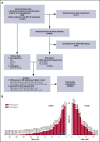Association between the HLA-DRB1*03:01-DQB1*02:01 haplotype and PF4/heparin antibodies
- PMID: 31648318
- PMCID: PMC6849947
- DOI: 10.1182/bloodadvances.2019000311
Association between the HLA-DRB1*03:01-DQB1*02:01 haplotype and PF4/heparin antibodies
Abstract
HLA-DRB1*03:01-DQB1*02:01 haplotype patients develop higher anti–platelet factor 4/heparin (PF4/H) levels following IV heparin exposure.
HLA-restricted antigen presentation may play a role in the formation of anti-PF4/H antibodies.
Conflict of interest statement
Conflict-of-interest disclosure: The authors declare no competing financial interests.
Figures




References
-
- Greinacher A. Heparin-induced thrombocytopenia. N Engl J Med. 2015;373(19):1883-1884. - PubMed
-
- Warkentin TE, Levine MN, Hirsh J, et al. . Heparin-induced thrombocytopenia in patients treated with low-molecular-weight heparin or unfractionated heparin. N Engl J Med. 1995;332(20):1330-1335. - PubMed
-
- Raschke RA, Curry SC, Warkentin TE, Gerkin RD. Improving clinical interpretation of the anti-platelet factor 4/heparin enzyme-linked immunosorbent assay for the diagnosis of heparin-induced thrombocytopenia through the use of receiver operating characteristic analysis, stratum-specific likelihood ratios, and Bayes theorem. Chest. 2013;144(4):1269-1275. - PubMed
-
- Chan CM, Woods CJ, Warkentin TE, Sheppard JI, Shorr AF. The role for optical density in heparin-induced thrombocytopenia: a cohort study. Chest. 2015;148(1):55-61. - PubMed
Publication types
MeSH terms
Substances
Grants and funding
LinkOut - more resources
Full Text Sources
Medical
Research Materials
Miscellaneous

